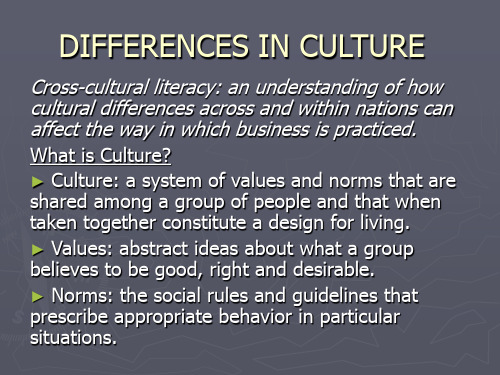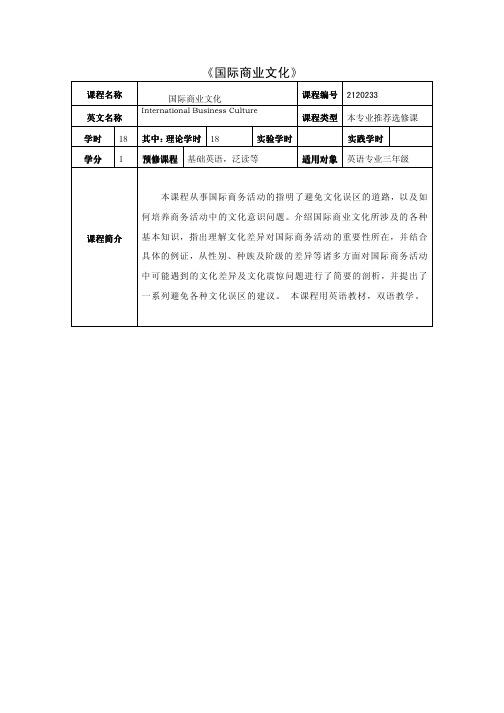Culture 国际商务 文化
Culture 国际商务 文化

a)
The individual Western: emphasize individual achievement. Brings benefits and harm. Benefits:
► ► ►
High level of entrepreneurial activity New products created High mobility – exposed to different ways of doing business High degree of managerial mobility between companies Bring bad impression to future companies Difficult to build teams within an organization to perform collective tasks.
i/ the degreenization is the individual, as opposed to the group. ii/ the degree to which a society is stratified into classes or castes.
2. Culture, Society and the Nation-State - nation-state are political creations - May contain a single culture or several cultures. - Cannot characterize a country as having a single homogeneous culture. - The national culture is a mosaic of subcultures.
国际商业文化PPT课件

Ambiguity-averse by nature
Buses and taxis taking visitors from Geneva’s airport to town would repeatedly broadcast the following announcement: “ Welcome to Switzerland . Have a good time and remember that in Switzerland everything that is not mandatory is forbidden.”
2021/7/24
26
不确定性 规避较高
的国家
日本、中国等亚洲国家。
人们尽量去避免不确定的和模棱 两可的东西,制订更多的正式规 则,不喜欢非同寻常的想法和做 法,寻求一致。
人们认为生活中充满了可能发生 的危险,对于书面的规定、计划、 规则、仪式有着强烈的要求,依 此来使生活有规则。
2021/7/24
2021/7/24
15
• 从文化的这个特点来看,北美文化具有个人主义特点。 以色列、阿拉伯国家、日本和中国文化则是集体主义 文化典型的例子。
2021/7/24
16
集体主义与个人主义群体的观点之不同
2021/7/24
Source: Hofsted 1991 P67
17
日本:突出来的钉子,将会被打下去。 In Japan, "the nail that sticks up is pounded down,"
2021/7/24
5
• 1)语言
• 语言不单指言语语言和书面语言。 • 通常,用言语表达出来的远没有非言语表达出来的重
国际商务第四章:文化差异

希尔国际商务(第9版)
4.3.2 社会阶层
社会流动性(social mobility)是指个人从自 己所出生的那个社会阶层流动到其他阶层的可 能性。
种姓等级制度(caste system)是一种封闭的社 会等级制度。在这一制度下,人们的社会地位是 由其出生的家庭所决定的,通常终其一生都不可 能 阶级制度(class system)是一种不太严格的社 会等级形式,在这种制度下,社会流动是可能的。 改变。
希尔国际商务(第9版)
4.2.2 文化、社会和民族国家
社会定义为拥有同一套价值准则的一群人,即 在同一种文化下生活的人。 一个社会与一个民族国家之间没有严格的一一 对应关系。 各个民族国家是政治的产物,它们可能包含一 种文化,也可能包含多种文化。
希尔国际商务(第9版)
4.2.3 文化的决定因素
在全球通信、快速运输、全球市场和 全球品牌来临的日子里,在世界的每一个角 落都几乎被纳入“地球村”的时代中,人们
很容易忘记各国文化的差异。事实上,在现
代化的外表下,依然存在深刻的文化差异。
希尔国际商务(第9版)
4.2 文化是什么
文化(culture)定义为一群人所共同拥有的、 为生存而设计构造的一种价值观和准则的体系。
希尔国际商务(第9版)
文化差异
第四章
希尔国际商务(第9版)
目 录
1
2 3 4 5
引言
文化是什么 社会结构
宗教与伦理体系
语言
6
7
教育
文化与工作场所
8
文化的变化
希尔国际商务(第9版)
4.1 引言
跨文化的知识能力(cross-cultural literacy),是指要了解不同国家的文化如
25国际商务文化 第2章基本文化类型

个人主义与集体主义
(individualism versus collectivism)
依赖于集体主义思维方式的社会珍视一致性, 并且试图通过外部约束——羞辱或者从集体 开除——来控制个人的行为。社会对超越集 体的个人成功是不能容忍的。在追求集体主 义的社会中,集体的压力控制着人们的行为, 而在以个人主义为导向的文化中,人们的行 为取决于自发的约束力,即自责。在以个人 主义为主流的文化中,决策更加迅速,但在 涉及政策调整的时候,却明显慢于集体主义 文化。在集体主义环境中,达成一致的意见 需要花很长时间,但执行起来很快。
【点评】老外也真是的。 我们中国人这么多人, 平日里也没有什么乐趣, 怎么还不兴趁着周日到 外面去凑凑什么热闹吗? 要知道,我们这个民族 是害怕寂寞的民族,是 不喜欢单独行动的民族, 是最讲究团结的民族啊。 此外,他有没有看过 “黄金周”的盛况呢? 右边的图中显示出来的 稠密程度,显然不够。
东西方文化差异
因此,在近权力距离的国家,经理们要做 好为每一项决策做出解释说明的准备,因为 那里的工人们期待你为自己辩护并寻找他们 的支持。
远权力距离
在远权力距离的社会中,雇员在决 策过程中往往不扮演任何角色。雇 员需要指示和纪律,他们依靠管理 者提供一切。与近权利距离不同, 在远权力距离的文化中,经理们不 可能微观管理雇员。而且,经理很 少期待雇员个人的首创性,他们只 希望雇员能够接受命令、把任务做 好。
从文化看,生活在不同地理生态环境和 文化生态环境之中的不同人种或种族的人们 在历史上形成的、共同的价值观念、思维方 式、心理状态、精神面貌等思想文化的最本 质特征,它具有系统性和变异性。
个人主义与集体主义
(individualism versus collectivism)
国际商业文化Lectu

•Rapid decision-making •Slow decision-making but slow implementation But rapid implementation
The belief that in society, everyone is supposed to take care of himself or herself and his or her immediate family
1. 为什么约翰先生与苏奇木拓的谈话会不愉 快?
2. 如果你是约翰先生,你会当众表扬苏奇木 拓么?
3. 如果你是苏奇木拓,你会如何处理这种情 景?
Power-Distance
According to Hofstede & Bond (1984), power distance is defined "as the extent to which the less powerful members of institutions and organizations accept that power is distributed unequally". In other words people in high power distance cultures are much more comfortable with a larger status differential than low power distance cultures.
On the other hand, in collectivist cultures it was said that any person through birth and other events belongs to one or more cohesive collectives (“in-group”), from which he or she cannot detach himself or herself. The in-group (for example, the extended family with grandparents and either paternal or maternal uncles, aunts, and cousins --- or on a larger scale, the nation and its governmental institutions) should protect the interests of its members but in exchange can expect their permanent loyalty.
国际商务文化的特点与应对策略

国际商务文化的特点与应对策略1. 引言1.1 概述国际商务文化在全球化的背景下变得越来越重要。
随着各国之间贸易和经济合作的不断增加,不同国家和地区之间的商务交流也日益频繁。
然而,由于各国之间存在着不同的历史、宗教、政治和法律体系等差异性因素,这为跨国商务活动带来了许多挑战。
因此,了解和应对国际商务文化的特点至关重要。
1.2 文章结构本文将分为五个部分进行论述。
首先,在引言部分,我们将对国际商务文化的概况进行简要介绍,并陈述本文的目的。
接下来,在第二部分,我们将详细探讨国际商务文化的特点,包括文化差异、沟通方式以及价值观和信念方面的内容。
紧接着,在第三部分中,我们将探究影响国际商务文化形成和发展的因素,如历史背景与地理环境、宗教与民族习俗以及政治和法律体系等。
在第四部分中,我们将提出一些策略来帮助企业应对国际商务文化带来的挑战。
这些策略包括跨文化培训和教育、建立良好的人际关系以及灵活应对各种情况等。
最后,在结论部分,我们将总结国际商务文化的特点,并展望未来发展趋势,同时给出结束语。
1.3 目的本文旨在通过对国际商务文化特点与应对策略的分析,帮助读者深入了解不同国家和地区之间商务交往中面临的各种文化差异和挑战。
同时,本文还旨在提供一些有效的策略和建议,以便企业能够在跨国商务活动中更加成功地进行合作,并更好地适应不同国家和地区的商业环境。
2. 国际商务文化的特点2.1 文化差异在国际商务领域,不同国家和地区的文化差异是一个重要的特点。
每个国家和地区都有独特的价值观、信仰系统、社会规范和行为习惯。
这些文化差异影响着人们在商务环境中的行为方式和决策过程。
例如,在某些国家,人们更注重个人关系和信任,而在其他国家,注重合同和法律。
2.2 沟通方式沟通方式也是国际商务文化的一个重要特点。
语言是沟通的核心工具,但在不同国家之间存在语言障碍。
即使使用相同的语言,不同国家和地区也会有不同的表达方式、隐喻以及非言语交流方式(如姿态、面部表情等)。
《国际商务文化》课件

• 国际商务文化概述 • 不同国家的商务文化 • 国际商务礼仪与沟通 • 国际商务谈判 • 国际商务环境与策略 • 国际商务案例分析
01
国际商务文化概述
定义与特点
定义
国际商务文化是指在跨国经营和贸易 中,不同国家和地区的文化背景、价 值观、行为准则和商业惯例的集文化具有多样性,不同 国家和地区之间存在差异,但普 遍重视关系和人情世故,商业决 策往往需要考虑到人际关系因素
。
03
国际商务礼仪与沟通
商务场合的礼仪
商务场合着装规范
根据不同国家和地区的文 化习俗,选择合适的着装 ,如西装、职业装等。
商务场合行为举止
遵循商务礼仪,保持礼貌 、得体的举止,如握手、 打招呼、致谢等。
商务场合交际技巧
了解不同文化背景下的交 际习惯,如称呼、问候、 告别等,以避免误解和冲 突。
商务沟通技巧
1 2
有效倾听
在商务沟通中,倾听是关键。要全神贯注地听取 对方意见,避免打断对方或过早表达自己的观点 。
清晰表达
在表达自己的观点时,要使用简洁明了的语言, 避免使用模棱两可或含糊不清的措辞。
3
适当提问
了解谈判风格
01
熟悉不同文化背景下的谈判风格,如直接或间接、竞争或合作
等,以制定相应的谈判策略。
灵活运用策略
02
根据谈判进程和对手情况,灵活运用不同的谈判策略,如让步
、妥协或坚持立场。
掌握议价技巧
03
了解并运用有效的议价技巧,如比较市场价格、突出产品优势
等,以达成有利于自己的协议。
谈判中的文化冲突与解决
由于政治原因导致的业务损失 风险,如政局动荡、贸易壁垒 等。
国际商务文化与礼仪要点

VS
详细描述
在选择餐厅和菜品时,要考虑到对方的口 味和文化习惯。例如,在西方国家,选择 正式的餐厅和穿着正式的服装较为常见; 而在一些亚洲国家,随意和舒适的餐厅更 为普遍。此外,餐桌上的话题和行为也要 尊重对方的文化和价值观。
案例三:商务出差中的礼仪与文化差异
总结词
在商务出差中,了解并遵守当地的礼仪和文 化习俗是展示专业素养和尊重的重要方式。
商务场合的言谈举止
总结词
恰当的言谈举止能够建立良好的商务关系。
详细描述
使用礼貌用语,注意语气和措辞,避免使用可能引起误解的俚语或方言。保持自信、冷静的态度,认真倾听对方 意见,尊重对方观点。避免谈论敏感话题,如政治、宗教等。
商务场合的用餐礼仪
总结词
了解不同文化和餐桌礼仪,避免因误 解造成尴尬。
详细描述
目光接触
副语言
包括姿势、动作、身体 接触等。
如微笑、皱眉、眼神等 。
通过眼神交流传达出信 任、尊重等情感。
如语调、音量、语速等 。
非言语交际在国际商务中的应用
握手礼
在商务场合,握手是一种常见 的问候方式,要注意力度、时
间和眼神交流。
商务宴请
在商务宴请中,要注意座位安 排、餐具使用、餐桌上的礼仪 等,以体现尊重和礼貌。
在国际商务中,应灵活运 用沟通技巧,根据不同的 文化背景和情境,采取适 当的沟通方式。
02
商务礼仪要点
商务场合的着装规范
总结词
得体的着装是商务场合中展现专业形象的重要一环。
详细描述
根据不同国家和地区的文化习惯,选择合适的服装,如西装、职业装等,以展现 专业、正式的形象。注意颜色搭配和整洁度,避免过于花哨或暴露的款式。
第二讲 国际商务环境(文化)

• 基督教对经济的影响:新教教徒的职业道德
某些社会学家认为,在基督教的两个主要分枝天主教和新教中 间,新教对经济的影响更为重要。1904年,德国社会学家马克斯·韦 伯( MaxWeber)将新教道德与“资本主义精神”联系起来,并因而 成名。 韦伯注意到资本主义兴起于西欧。他指出,在西欧:商界领 袖、资本家、高级技工、以至现代企业中受过高等技术和经济学培训 的人员、全都是新教教徒。 新教的道德观强调努力工作和创造财富的重要性( 为了上帝的 荣耀) 和节俭(节制世俗享乐) 。这正是促进资本主义发展所需要的 那种价值观。新教徒工作刻苦并且按步就班地积累财富。他们的禁欲 主义信仰,使他们不是将财富消耗在纵情的世俗享乐之中,而用于扩 张资本主义企业的再投资。这样,刻苦工作和资本积累( 用于金融投 资和扩展企业) 相结合,为西欧及美国的资本主义发展铺平了道路。
2、教育的差异对商务活动的影响:
教育影响消费观念和消费模式; 教育影响营销活动的开展;
(五)宗教
世界五大宗教 基督教 伊斯兰教 印度教 佛教 儒教
基督教
基督教是世界上传播最广的宗教。大约 有10亿人,即世界人口的20%是基督教徒。 绝大多数基督教徒生活在欧美两洲。在非 洲,基督教徒的数目增长也很快。基督教 源自犹太教。和犹太教一样,它是一神教 (只信奉一个上帝)。
中国
美国
日本
印度
巴西
德国
英国
韩国
意大利
法国
俄罗斯
加拿大
伊朗
墨西哥
西班牙
越南
巴基斯坦
波兰
马来西亚
荷兰
台湾
占比 19.1% 74.1% 69.1% 7.1% 26.3% 51.6% 66.1% 72.6% 55.0% 49.1% 21.2% 83.9% 35.2% 21.0% 48.7% 21.0% 9.9% 41.6% 61.7% 90.5% 57.8%
《国际商务文化》教案

International Business Culture袁克蕙Chapter 1 Introduction1. About this course●It has become commonplace knowledge that globalization is one of the major forces shaping our world. If we look at the spread of information, ideas, capital, media, cultural artifacts — or for that matter, people — we can see the boundaries and borders that have historically separated one country or one group from another are becoming more and more permeable. For proof of this close to home, you need only to look at the transnational corporations in our country. Most students study hard in order to get a chance to work in the transnational corporations. Even if you have a company of your own, it‘s still necessary for you to deal with business with people from different countries. Introduction●―International Business Culture‖ is designed to help you meet the challenges of living in a world in which, increasingly, you will be asked to interact with people who may not be like you in fundamental ways. Its overarching goals are to help you become sensitive to intercultural communication differences, and to provide you with the knowledge and skills that will help you interact successfully with people from cultures other than your own. We hope the course will accomplish those goals by expo sing you to Charles Mitchell‘s book on this subject, and by giving you a variety of opportunities to practice intercultural communication yourself.Introduction2. Course aim: to improve culture awareness mainly through reading activities, together with some presentation exercises.Course duration: 1st— 16th week (2(3) periods weekly)Course requirements: 4PsPresence: to show up for classPunctuality: to attend on timePreparation: to preview the textPresentation: to be active in team work●What is culture?●What are the core elements of culture?●Why is learning culture important?●To what extent can culture have a significant impact on international business?●Can you give some examples of cultural difference or culture clash?Concepts of ―culture‖●以文教化,人文教化。
国际商业文化

Social Etiquette CultureSocial etiquette is that people in the process of interpersonal communication have the basic qualities, communication skills and so on. Interpersonal social interaction in today's society to play a role in more and more important. Through social, spiritual people can communicate, and building friendships, get support and help; through social, people can exchange information, share resources, success in our cause a great benefit.First, the exchange of informationAlso known as share information resources. We need to get a lot in life for the livelihood of reference information, the limited scope of activities due to personal, direct access to primary information resources will be greatly restricted, and this is mostly a large number of information we obtain when dealing with others the past. For example, we drove to another place, of which there are road or section of road traffic accidents and closed to traffic, so if we do not know this information, we will be according to the original line of march, had changed in the middle opposite direction, but if we are through friends or relatives or colleagues, or broadcast television networks and other social media learned of this news, we will go the amendment route in advance, less costly mistakes.Second, to promote feelingsInvest in social time will bring emotional gains, such as relatives and friends with our entertainment.Third, the relationshipIn many cases social establishment of such business cooperation, emotional bond between marriage and so on. In the course of a relationship, remember to learn to follow up the relationship, to avoid forget. Japan has dense, sparse on day away. Fourth, self-enrichmentWealth of life experience and human emotion.Therefore, I would like to learn more about social etiquette cultural.Outlin e:1.What is social etiquette cultural2.Differences in social etiquette in the West3.Social Etiquette on the impact of business activitiesSocial Etiquette Culture1. What is social etiquette culturalSocial etiquette is that people in the process of interpersonal communication have the basic qualities, communication skills and so on. Interpersonal social interaction in today's society to play a role in more and more important. Through social, spiritual people can communicate, and building friendships, get support and help; through social, people can exchange information, share resources, success in our cause a great benefit.Culture is the formation of social etiquette and a science.Right since childhood, our parents and teachers teach us to be polite and good mannered with people and society. How much do we grow up to practice? There are many types of etiquette that we should possess as they all add up to our personality and image we create in society. You need etiquette in school, college, office, neighborhood, parties or even on the street and everywhere you come across strangers and people. This etiquette which involves the society is in short called social etiquette which are very important for our survival in the society. When you are interacting with a group of people as your seniors, colleagues or juniors you need to have a certain sense of speech as well as body language. This etiquette defines who you are in your future. Given below are some rulesand regulations for social etiquette 。
国际商务文化范文

国际商务文化范文国际商务文化是指在全球范围内进行商务活动时涉及到的文化因素。
由于全球化的发展,国际商务文化的重要性也越来越凸显,它涉及到不同国家和地区的商务活动中的礼仪、价值观、信任等因素。
本文将分析国际商务文化的重要性以及不同文化之间的差异,以帮助企业在国际市场中取得成功。
首先,国际商务文化在全球化的背景下具有重要的作用。
随着世界各地经济的互联互通,跨国企业可以轻松地进入其他国家市场。
然而,每个国家都有自己独特的商务文化,这可能会对企业的商务活动带来挑战。
因此,了解和尊重不同国家的商务文化是保障跨国企业成功的关键。
其次,国际商务文化的差异是企业成功与否的重要因素。
每个国家的商务文化都受到其历史、宗教、价值观等因素的影响。
例如,在东亚国家,如中国和日本,重视关系和信任是商务成功的重要因素。
在这些国家,建立个人关系对于企业的长期发展至关重要。
而在西方国家,如美国和英国,商务活动更注重效率和竞争力。
因此,企业必须了解并适应不同国家的商务文化,以便在国际市场中成功。
此外,了解国际商务文化还可以帮助企业避免文化冲突。
在国际商务交往中,不同国家之间的文化差异可能会导致误解和冲突。
一些行为在一个国家可能被视为礼貌和尊重,而在另一个国家可能被视为冒犯。
通过了解和尊重不同国家的商务文化,企业可以避免这些冲突,并更好地与国际合作伙伴交流和合作。
最后,国际商务文化的重要性还在于其对企业形象和声誉的影响。
每个国家都有其独特的商务礼仪和行为准则。
企业在国际商务活动中遵循这些准则,表明了其对当地文化的尊重,提升了其在国际市场中的形象和声誉。
相反,如果企业无视当地文化,可能会破坏其声誉,导致商务合作的失败。
总之,国际商务文化在全球化时代具有巨大的重要性。
了解和尊重不同国家的商务文化是企业在国际市场中取得成功的关键。
国际商务文化的差异对于企业的商务活动具有重要影响,了解这些差异可以帮助企业避免冲突并提升形象和声誉。
因此,企业应该注重国际商务文化的学习和应用,以在全球市场中获得竞争优势。
国际商务谈判 第2版 第2章 文化在国际谈判中的作用

2.4 更深层次的文化特征
• 2.4.1 霍尔的理论框架
• 关系
• 这种文化是关注交易还是关注关系?
目录
CONTENTS
2.1 文化对谈判的影响 2.2 理解文化 2.3 礼节和举止 2.4 更深层次的文化特征 2.5 关键人物和决策过程 2.6 跨文化谈判中特有的问题
2.3 礼节和举止
• 谈判人员可以参考图表2-2,寻找一些关于礼节和举止问题的答案。
问候 正式程度 礼物赠送
触摸 眼神接触
举止 情感 沉默 用餐 肢体语言 时间观念
目录
CONTENTS
2.1 文化对谈判的影响 2.2 理解文化 2.3 礼节和举止 2.4 更深层次的文化特征 2.5 关键人物和决策过程 2.6 跨文化谈判中特有的问题
2.1 文化对谈判的影响
• 文化是没有商量余地的。无论交易成功与否,人们都不会为了生意而改变自己 的文化。
• 谈判人员应该接受彼此之间的文化差异,并尽力理解这些差异。 • 文化差异会以意义重大且意想不到的方式影响商务谈判。
文化特征
信念 寻求的目标 决策方式 自己的角色定位
关注点 对谁负责 谈判方式 重视点
沟通方式
创业者/ 初创公司的谈判人
员 勇于冒险 高收益
快速 执行者 快速增长 自己/合作伙伴 小型团队/单独 自我实现 直接/使用技术术
语
企业类型
跨国公司的谈判人员
愿意承担适度的风险 可持续高利润 果断 决策者 声誉 利益相关者 多学科团队 权力
人们如何彼此问候和称呼?商务名片起什么作用? 谈判对方希望我正式地还是非正式地着装以及与其互动? 商务人士是否会交换礼物?什么样的礼物更合适?礼物赠送是否有禁忌?
人们对身体接触持什么态度? 直接的眼神接触是否礼貌?对方是否希望我这样做?
国际商务文化毕业论文

国际商务文化毕业论文由于全球一体化的发展,不同文化背景的人们经济合作越来越频繁,增强跨文化理解、克服文化冲突,为了加强文化传通和合作,国际间的商务文化就显得非常重要了。
下文是店铺为大家整理的关于国际商务文化毕业论文的范文,欢迎大家阅读参考!国际商务文化毕业论文篇1国际商务中的跨文化管理再研究摘要:世界经济一体化发展,跨文化管理已经成为中外企业在国际商务活动中亟需解决的难题之一。
因此,了解文化差异对跨国企业的影响,注重跨文化市场营销中文化差异对市场的调研,学习国际商务谈判中跨文化的交流技巧,采取有效的跨文化人力资源管理策略,是企业跨国经营成功关键。
关键词:国际商务;文化差异;跨文化市场营销;跨文化管理;沟通与谈判随着经济全球化的不断发展和对外开放的不断深化,国际商务活动日趋活跃,跨国企业在国际贸易市场中的竞争也日益激烈,然而在国际商务活动中如何解决跨文化的矛盾与冲突成为了企业成功与否的关键。
因此,了解文化差异对跨国企业的影响,注重跨文化市场营销中文化差异对市场的调研,学习国际商务谈判中跨文化的交流技巧,采取有效的跨文化人力资源管理手段。
将国际商务经营活动中的文化冲突降低到最低程度,使我国企业在参与国际贸易竞争过程中,不仅适应国际商务活动主体之间的经济环境,更能适应相互之间的文化环境,并且取得竞争优势和获得国际经营活动主动权,是我国企业在跨文化国际商务活动中所必须重视和值得研究的问题。
一、文化差异是影响我国企业进行国际商务活动的一项重要因素文化是不同自然背景和社会背景下的价值观念,风俗习惯的表现,不同的国家有不同的社会环境,从而决定了不同地域的人有不同的生活方式和文化内涵。
文化差异对国际商务活动的影响是广泛而深刻的。
例如,在判断和理解人与人之间的关系上,西方文化倡导个人利益至上,以实现自我价值为根本出发点,强调自我发展,个人奋斗。
在国际商务活动中则体现为以个人的工作能力来衡量整个企业的效率,用自我意识和创新意识实现自身的价值;但对于中国企业而言,个人利益永远服从于集体利益,当个人利益与集体利益发生冲突时个人不能做有损于集体利益的事情,个人永远是为集体服务的,其创造的价值最终归属于整个企业的福利而不是个人的成果。
1国际商务谈判与文化

1. 国际商务谈判与文化1.1商务谈判与文化的关系文化,是指通过社会关系的相互传递从而被大家认同的行为特征和价值观.它包括知识、信仰、艺术、道德、法律、习俗等等。
文化的概念广泛且庞杂,包括人们生活的各个方面,涉及人们精神上和生理上的各种需要。
而且人类强调文化有三大特点:(1)文化不是个人特质,而是个人所属的社会的特质;(2)文化是个人通过文化适应和社会交往从所属社会习得的;(3)每一种文化都是一组复杂的与众不同的特征,涉及到社会生活的各个方面。
而就国际商务谈判而言,是指处于不同国家和地区的商务活动的当事人,为满足各自需要,通过信息交流与磋商争取,最终使各谈判方的需求相互得以调和,互相接近从而达成一致意见的过程。
本文要强调的并不是仅仅是文化或谈判,而是要讨论文化差异对谈判所产生的影响。
文化并不仅仅影响到跨文化谈判者的谈判方式,而且谈判各方在文化上的不一致,也会影响到谈判的进程和最终结果。
在跨文化谈判中,由于谈判主体属于两个或两个以上的国家或地区。
语言、信仰、生活习惯、价值观念、行为规范、道德标准乃至谈判的心理都有着极大的差别.这些方面都是影响谈判进行的重要因素。
当双方跨越文化进行谈判的时候,双方都把各自的文化摆到了谈判桌上。
在这个过程中。
文化常以一种微妙的方式影响人们的谈判态度与谈判行为。
这种效应好似“以石投水”,石子激起涟漪,向整个池面漾去,文化就弥漫在整个水面之中,并且渗透到谈判的方方面面。
因此文化对谈判的影响是显而易见的,也是十分重要的。
2. 中国奥康公司与意大利GEOX公司案例2.1案例背景中国浙江奥康集团是中国国内最大的民营企业之一,是国内知名鞋业生产企业。
GEOX 公司是意大利排名第一的功勋企业、世界鞋业巨头之一。
2001年中国加入世贸组织之后,GEOX公司把目光瞄准了中国市场,意图在中国建立一个亚洲最大的生产基地。
为此,从2002年开始,GEOX公司总裁POLEGATO先生开始在亚洲进行市场调研,其间花费了两年时间对中国市场进行了调研,先后考察了八家中国著名鞋业公司,最终将目标对准了中国的奥康集团。
国际商务文化总结

国际商务文化总结在当今全球化时代,国际商务的发展日益重要。
国际商务不仅涉及到跨国贸易、投资与合作,还包括了涉外礼仪、商务谈判和文化差异的处理。
了解并尊重不同国家和地区的商务文化,是成功进行国际商务活动的基本要素之一。
1. 尊重文化差异不同国家和地区有不同的商务文化,这与历史、宗教、价值观以及社会环境等诸多因素有关。
在开展国际商务活动时,尊重并理解对方的文化差异是至关重要的。
例如,在与中国人进行商务交流时,应该尊重他们的传统价值观念,注重面子和人情关系。
而与日本人进行商务谈判时,则需要遵守其严谨的礼仪规范,注重团队合作和共识的建立。
2. 跨文化沟通能力在国际商务中,良好的跨文化沟通能力是至关重要的。
首先,语言能力是有效沟通的前提,尽量学习对方的语言并熟悉其商务用语。
其次,要注意语言的表达方式和传达信息的方式,避免使用可能引起误解或冲突的词汇或句子。
最后,注重非语言沟通,如姿势、眼神、面部表情和身体语言等。
这些都可以传递出不同的文化信息和含义,对于建立信任和达成合作至关重要。
3. 地域文化及宗教信仰了解并尊重商务伙伴所处地域的文化和宗教信仰是成功的关键。
例如,向伊斯兰教国家的商务伙伴提供猪肉或酒精饮品可能会造成冒犯,而在印度教国家触摸别人的头部则被视为不尊重。
对于某些国家,商务活动可能会受到宗教节日、习俗和风俗的影响,因此需提前了解并妥善安排。
4. 礼仪与商务活动在国际商务活动中,遵循正确的商务礼仪能够增加信任和合作的机会。
这包括了仪表仪容的整洁、正确的称谓、握手礼节、名片的递交和接收等。
在不同国家和地区,商务与社交活动往往密切相关,因此善于处理商务餐饮、宴请和庆祝活动是至关重要的。
5. 时间观念和商务谈判不同文化对待时间的态度各不相同。
一些国家非常注重准时,如瑞士和日本,而其他国家则较为灵活,如巴西和阿拉伯国家。
在商务谈判中,了解对方的时间观念并灵活应对非常重要。
此外,还需注意谈判的方式、沟通风格和谈判策略的文化背景,以确保双方能够达成合作共识。
《国际商业文化》

《国际商业文化》 课程名称课程名称
国际商业文化 课程编号课程编号 2120233 英文名称英文名称
International Business Culture 课程类型课程类型 本专业推荐选修课 学时学时
18 其中其中::理论学时理论学时 18 实验学时实验学时 实践学时实践学时 学分学分 1 预修课程预修课程 基础英语,泛读等
适用对象适用对象 英语专业三年级
课程简介课程简介
本课程从事国际商务活动的指明了避免文化误区的道路,以及如何培养商务活动中的文化意识问题。
介绍国际商业文化所涉及的各种基本知识,指出理解文化差异对国际商务活动的重要性所在,并结合具体的例证,从性别、种族及阶级的差异等诸多方面对国际商务活动
中可能遇到的文化差异及文化震惊问题进行了简要的剖析,并提出了一系列避免各种文化误区的建议。
本课程用英语教材,双语教学。
- 1、下载文档前请自行甄别文档内容的完整性,平台不提供额外的编辑、内容补充、找答案等附加服务。
- 2、"仅部分预览"的文档,不可在线预览部分如存在完整性等问题,可反馈申请退款(可完整预览的文档不适用该条件!)。
- 3、如文档侵犯您的权益,请联系客服反馈,我们会尽快为您处理(人工客服工作时间:9:00-18:30)。
Culture and the Workplace - How a society‟s culture affects the values found in the workplace. - Management process and practices may need to vary according to culturally determined workrelated values. - Famous study of how culture relates to value in the workplace was undertaken by Geert Hofstede. - Compare dimensions of culture. - 4 dimensions: power distance, uncertainty avoidance, individualism vs collectivism and masculinity vs femininity.
What is Culture? ► Culture: a system of values and norms that are shared among a group of people and that when taken together constitute a design for living. ► Values: abstract ideas about what a group believes to be good, right and desirable. ► Norms: the social rules and guidelines that prescribe appropriate behavior in particular situations.
►
Society: a group of people who share a common set of values and norms. Values and Norms Values form the bedrock of a culture Provide the context within which a society‟s norms are established and justified. Include a society‟s attitudes toward concepts such as individual freedom, democracy, social obligations, etc. Values are invested with considerable emotional significance
Harms:
► ► ►
b) The Group Contrast to Western, group is the primary unit of social organization in many other societies. Japan: social status is determined as much by the standing of the group to which he/she belongs. Create pressures for mutual self-help and collective action. Close cooperation between different functions. Discourage the mobility.
2. Social stratification - Societies stratified on a hierarchical basis into social categories which is social strata. - Defined on the characteristics: family background, occupation, income. a) Social Mobility - refers to the extent to which individuals can move out of the strata into which they are born. - varies significantly from society to society. - most rigid system: caste system (closed) - less rigid: claoken language
2.
Enable the communication Verbal communication Shapes the way people perceive the world and also helps define culture
Unspoken language
3. The determinants of culture Social structure Religion Political philosophy Economic philosophy Education Language Social Structure A society‟s “social structure” refers to its basic social organization. 2 dimensions when explaining differences between cultures:
b) Significance - Business perspective, the stratification of a society is significant if it affects the operation of business organizations. - The relative lack of class mobility and the differences between classes have resulted in the emergence of class consciousness. - Class consciousness: a condition where people tend to perceive themselves in terms of their class background and this shapes their relationships with members of other classes.
1.
Norms are social rules that govern people‟s actions toward one another. Can be subdivided into 2: folkways and mores.
a) Folkways – the routine conventions of everyday life.
1.
Individuals and Groups - groups: an association of 2 or more individuals who have a shared sense of identity and who interact with each other in structured ways on the basis of a common set of expectations about each other‟s behavior. - Individuals are involved in families, work groups, social groups, etc.
b) Mores – norms that are seen as central to the functioning of a society and to its social life
• Greater significance than folkways • Violating mores can bring serious retribution • Include factors as indictments against theft, adultery, incest and cannibalism.
► ► ►
Action of little moral significance Social conventions concerning things such as the appropriate dress code, good social manners, etc. Define the way people are expected to behave.
DIFFERENCES IN CULTURE
Cross-cultural literacy: an understanding of how cultural differences across and within nations can affect the way in which business is practiced.
2. Culture, Society and the Nation-State - nation-state are political creations - May contain a single culture or several cultures. - Cannot characterize a country as having a single homogeneous culture. - The national culture is a mosaic of subcultures.
i/ the degree to which the basic unit of social organization is the individual, as opposed to the group. ii/ the degree to which a society is stratified into classes or castes.
